BLITZ CULMINATES IN LONDON DEVASTATION
London, England • May 10/11, 1941
Although it would not be known for over a month, the Luftwaffe raid on London on this night, May 10/11, 1941, brought closure to Nazi Germany’s 15‑month strategic bombing campaign of Great Britain and Northern Ireland. The British public dubbed the aerial campaign the Blitz (September 7, 1940, to May 10, 1941), shorthand for the German word Blitzkrieg, “lightning war.” The Blitz was German leader Adolf Hitler’s punishment for Britain’s refusal to surrender their isles to him the previous year during the Battle of Britain (July 10 to October 31, 1940).
“There’s something big on tonight, sir,” were the first words Fighter Command Headquarters in Middlesex, north of London, heard of the appearance of Heinkel He‑111 bombers crossing the English coast, this at about 10:45 p.m. on a well-lit Saturday night in May 1941. A half hour before, radar stations along the Channel coast had been tracking huge bomber fleets with thousand-pound/454‑kilogram loads leaving airfields in German-occupied France and Holland. The month before 2 heavy raids had struck London from the same fields. Tonight would mark Luftwaffe chief Hermann Goering’s third maximum-effort raid in less than 30 days.
Twenty minutes after Middlesex Fighter Command Headquarters had received its initial dispatch the first 550‑pound/249‑kilogram high-explosive bombs and incendiaries punched through Londoners’ roofs, igniting hundreds of small fires. Individual fires spread through bombed-splintered buildings and merged into major conflagrations within minutes. Searchlight beams scissored the night sky trying to locate the intruders. Antiaircraft defenders were overwhelmed by the number of enemy aircraft. Fire spotters and fire brigade men did their best to smother bombs with sand and direct water hoses on burning structures, many nearing collapse as roofs and beams and upper floors cascaded down to the ground floor or into basements, turning walls and windows into deadly shrapnel. All London was the target, from Thames warehouses to business, industrial, and residential districts to outlying neighborhoods. The cries of the dying and wounded as they attempted to escape from the wreckage all around them were drowned out by the sounds of explosions, raging firestorms, crumpling buildings, and thousands of whirring fire pumps. Londoners and communities up to 20 miles/32 kilometers away were shocked as they witnessed the intensity and fury of the nocturnal raid. From a distance all London resembled one big red flame. Within the city itself the color of the flames resembled a kaleidoscope of endless colors depending on what burned: chemicals burned a brilliant white and emitted little smoke, rubber a deep red giving off thick plumes of black smoke, etc.
The air raid lasted till daybreak Sunday, May 11. In fact, it lasted long enough for some returning aircrews to land, refuel, reload, and take off for London a second time. The last bomb the raiders dropped destroyed a portion of Scotland Yard. It was 5:37 a.m. but who outside the Observation Corps that manned the coastal radar stations knew that it would be the last bomb the enemy delivered? The all-clear sounded at 5:52, 2 minutes after the last intruding aircraft cleared the English coast. In all of 7 hours, 1,486 Londoners had been killed, 1,800 seriously injured, an estimated 11,000 homes destroyed, and over 12,000 people made homeless in a particularly savage climax to the Blitz that saw 505 enemy aircraft drop 708 tons of high-explosive bombs and over 86,000 incendiaries. About 2,200 fires were started. Across 700 acres/283 hectares of the city 2,000 of them burned out of control and would continue to burn for days after the raid. Damaged landmarks included the British Museum, Westminster Abbey, the 844‑year-old Westminster Hall, St. James Palace, Big Ben bell tower, and both houses of Parliament. The British House of Commons was irretrievably lost due to a fire. As tallied by the Germans, all the RAF had to show for its defense of the British capital were 14 downed bombers.
The Blitz, Germany’s Strategic Bombing of Great Britain and Northern Ireland, September 7, 1940, to May 10, 1941
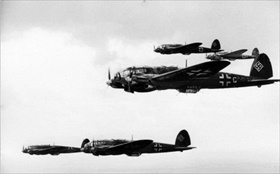 | 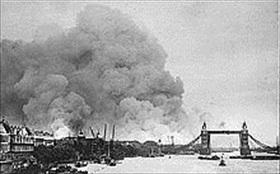 |
Left: A partial group of Luftwaffe Heinkel He-111 twin-engine medium bombers (nicknamed “Flying Pencils”) wings its way toward a target somewhere in England. Dorniers and Junkers Ju 88s joined the Blitz. Though the Royal Air Force bloodied the Luftwaffe during Battle of Britain (July 10 to October 31, 1940), the enemy’s intense bombing of British cities continued into the spring of 1941, with London taking great punishment during the Blitz. Across the nation many other civilian and industrial targets faced similar onslaughts—Liverpool, Cardiff, Bristol, Manchester, Belfast, Coventry, and Glasgow to name a few. Bombing failed to demoralize the British into surrender or do much damage to Britain’s war economy; 8 months of bombing never seriously hampered British war production, which continued to increase as did U.S. Lend-Lease supplies to America’s European allies. The greatest effect of Germany’s strategic bombing campaign was to force the British to disperse the production of aircraft and spare parts. British wartime studies concluded that cities generally took 10 to 15 days to recover when hit severely.
![]()
Right: Wood and food supplies that had survived the hazardous journey across the Atlantic went up in smoke at Surrey Commercial Docks on the Thames east of Tower Bridge in Southeast London on the start date of the Blitz, September 7, 1940. Thames fireboats pumped water at the flames as paint on their vessels peeled off in the heat. Surrey Docks was a square mile/259 hectares of fire with 1,000 pumps trying to control it. During the course of the London Blitz, over 100,000 tons of shipping was damaged in the Thames Estuary, 800 civilians were injured, and 400 civilians were killed. Between January and May 1944 the Luftwaffe assaulted Southern England in an operation codenamed Operation Steinbock (Unternehmen Steinbock), known colloquially as the “Baby Blitz.” The operation—retaliation for British Bomber Command’s ever-increasing airstrikes on German industrial cities—achieved very little other than reducing the capability of the Luftwaffe to repel the Allied invasion of Europe on D-Day, June 6, 1944. Steinbock turned out to be the last strategic air offensive by the German bomber arm during World War II.
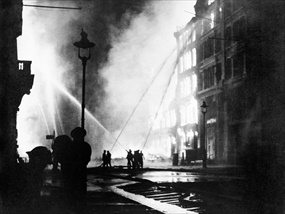 | 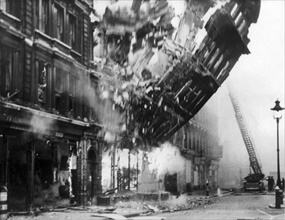 |
Left: Firefighters of the London Fire Brigade bravely battle a conflagration on Queen Victoria Street with water hoses during the devastating overnight air raid on the capital city on May 10/11, 1941. Less than halfway into the 37 weeks of the Blitz, Luftwaffe hordes had dropped more than 13,000 tons of high explosives and nearly 1,000,000 incendiaries on London. The number of bombers varied from night to night; for example: October 6, 7 bombers; October 15, 380. Using a scatter-gun approach, they dropped their deadly payload everywhere: on Westminster Abbey, St. Paul’s Cathedral whose dome dominated the skyline, Buckingham Palace (9 times during the war), No. 10 Downing Street (the official home of the British prime minister), the Tower of London (dating from 1086), the British Museum, on hospitals, theaters, churches, the London Zoo, on rich and poor neighborhoods, and on arguably military and war-industrial installations. After Buckingham Palace had suffered a hit on September 13, 1940, Queen Elizabeth, wife of King George VI, remarked that damage to the queen’s apartments meant she could better empathize with ordinary citizens. So, too, could Queen Wilhelmina of the Netherlands, who was a guest at the palace.
![]()
Right: The façade of another building on Queen Victoria Street is captured in mid-collapse in this startling image taken during the May 10/11, 1941, Blitz. German incendiary bombs had burned out the interior of the building and weakened it so that the exterior toppled spectacularly while firefighters watched behind the relative safety of a nearby extension ladder (right in photo). London was fortunate to have 6,000 regular firefighters and 60,000 auxiliaries, plus tens of thousands of part timers—men and women who had full-time jobs as well.
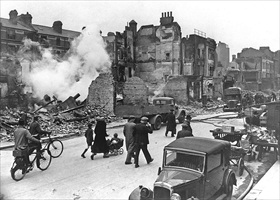 | 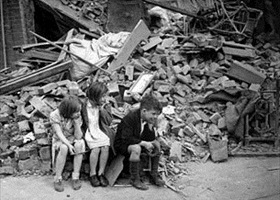 |
Left: A street of ruined houses in London. More than one million London houses were destroyed or damaged and close to 20,000 Londoners killed during the 267 days of the Blitz. The city was scarred but not devastated because its great sprawl meant that the violence lacked concentration. By contrast the Allied bombing raid on the large North German port and industrial center of Hamburg (population 1.8 million) during the last week of July and the first week of August 1943 (Operation Gomorrah) killed 42,600 civilians, of which 7,000 were children or adolescents, wounded 37,000, and practically leveled the city in a series of one-two punches, first by high explosives and then by incendiaries: 9,000 tons of bombs in all. Local rescue efforts stalled after British bombers cut electricity to a major portion of the city for 2 weeks. One million Hamburgers fled the city, where in just 8 days over 250,000 residences were destroyed. In the case of Hamburg, London, and every other European city that was at war and became the target of enemy bombings, the number of non-civilians (that is, combatants) killed was low.
![]()
Right: Children of an eastern suburb of London made homeless by the Blitz. Though militarily ineffective, the Blitz caused enormous damage to Britain’s infrastructure and housing stock. An estimated 1 in 6 Londoners suffered homelessness during the bombing campaign. Families who were “bombed out” were sent to so-called Rest Centers such as church halls.
Amateur Color Film of Destruction Caused by London Blitz, 1941 (Suggest silencing the projector’s sound)
![]()

 History buffs, there is good news! The Daily Chronicles of World War II is now available as an ebook for $4.99 on Amazon.com. Containing a year’s worth of dated entries from this website, the ebook brings the story of this tumultuous era to life in a compelling, authoritative, and succinct manner. Featuring inventive navigation aids, the ebook enables readers to instantly move forward or backward by month and date to different dated entries. Simple and elegant! Click
History buffs, there is good news! The Daily Chronicles of World War II is now available as an ebook for $4.99 on Amazon.com. Containing a year’s worth of dated entries from this website, the ebook brings the story of this tumultuous era to life in a compelling, authoritative, and succinct manner. Featuring inventive navigation aids, the ebook enables readers to instantly move forward or backward by month and date to different dated entries. Simple and elegant! Click 











